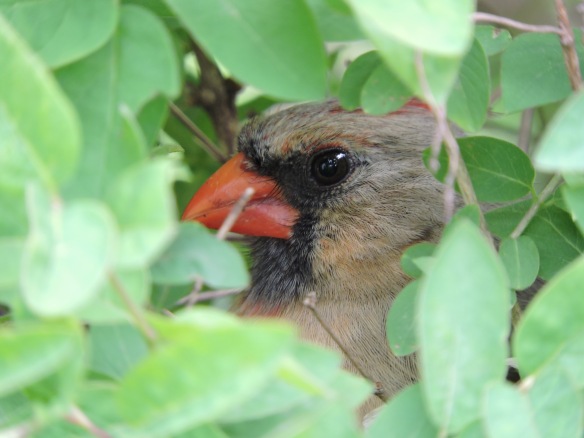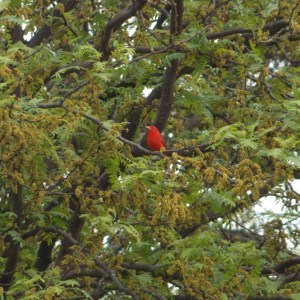Disclaimer: This is another post about yard birds. And the yard birds in question are cardinals.

Mama Pam
Our yard has a Northern Cardinal nest in the bushes along the edge of our back yard. The kids enjoy watching the pair, named Jim and Pam (as are all male and female cardinals anywhere, respectively). Even Alice, who is 21 months old, can proclaim “Jim!” when the male lands on the bird bath.
These birds have had a hell of a time in the month we have lived with them. It all started with the grosbeaks, who were here for three days but fiercely bullied all comers away from the feeders. This was good news with regard to our House Sparrows (who also have a colony of two nests on our front porch that have blown down three times between them), but it seriously strained the abilities of our Jim and Pam.

House Wren
Throw in a House Wren (unnamed) whose territory seems to overlap entirely with that of the cardinals and will chase away any and all birds who get too close to him, and you have quite the stressful situation.

Cardinal Nest
To top it all off, in investigating the nest while the parents were both away I noticed that one of their dear brood seems to be a cowbird. The young’un in the back of the nest may be decrying this, or it may just be begging for another helping of arthropod. In any case, Jim and Pam are raising a child of their own as well as a foster child in this hellacious suburban wildlife environment, and they are dealing with it admirably…

Oh snap.
While at the neighborhood park this past weekend, Jaime, the kids, and I discovered three raccoon babies all doing various raccoon-y things in different corners of the park. For the first time, I broke into the “animals are wild, they aren’t pets like Emma the Dog, etc, etc.” speech with Walter. This seemed to go over well. Until the next evening when one of them showed up in the cedar trees alongside our house. The kids lost their minds.
We tried to restrain Walter and Alice from running up to the raccoon while simultaneously encouraging them to observe the wildlife. Then it dawned on me what the little beast was really up to. A red blur flashed into the cedars at the same instant.

Jim the Cardinal sizes up the threat
Jim had exactly the same thought as I did. He zoomed in from out of nowhere to let the raccoon (bottom right) know that he was there (top left). Jim stood his ground for a few moments, trying to decide how much the raccoon actually knew.

Secret Nest Location
This photo is immediately to the right of the one above it. The cardinal nest is midway up the vegetation directly in front of the utility pole. For a minute, it seemed like the clumsy young raccoon was just going to blunder into traffic, and it actually fell out of the cedar tree and landed on its head. But then it did a 180 and headed right for the bushes.

The action builds
At this point, it was obvious that the raccoon knew there was something good to be had, but it couldn’t quite figure out where. This is when Jim really sprang into action. He flew down to the raccoon’s level and unleashed a devastating series of “chip chip chips” in its general direction. For a moment I thought he might go full Killdeer and feign injury to draw the predator away, but he was honest about his status as defender of the nest, and with erect crest he continued to hop around issuing warning calls.

The plan is working
The plan worked to perfection. The raccoon became much more interested in the bright red thingy making noise, and it followed Jim far into the neighboring yard and out of sight. It did not come back.
Jim and Pam meanwhile earned a well-deserved break, and within minutes of the all clear they were both leisurely eating back at the feeders.

Gray Catbird
Or least they were until the catbirds ran them off. What a life to be a cardinal in this day and age.
















